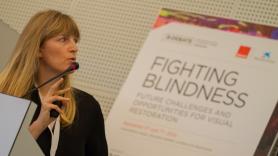1. Age-related macular degeneration, a high-priority problem
The macula is a small area of the retina, an approximately one-millimeter yellowish zone, that controls high-acuity vision and allows us to read or recognize faces accurately, for example. For several different reasons, in general mainly due to genetic predisposition along with environmental risk factors like smoking and obesity, age-related macular degeneration (AMD) is the main cause of serious loss of vision in developed countries.
Part of the research being done on AMD is focusing on genetic studies, trying to untangle the causes of the degeneration in order to better attack them. However it is turning out to be particularly complex. According to Marius Ueffing, director of the Institute for Ophthalmic Research in Germany, “We thought that understanding the genome would lead directly to solutions, but it is somewhat more complex and depends on the environment, and can even be random.” In fact, there seem to be very different ways and paths to reach the same result.
“We thought that understanding the genome would lead directly to solutions, but it is somewhat more complex and depends on the environment, and can even be random”
The studies presented by Caroline Klaver – professor of Epidemiology and the Genetics of Eye Diseases at the Erasmus Medical Center in the Netherlands – show that the genetic variables most frequently associated with AMD have very little influence on risk, and those that do carry more weight are particularly rare among the population. According to Klaver, and paraphrasing psychologist Charles Brewer, “Heredity deals the cards but environment plays the hand.” For example, in order to predict whether a person will develop AMD, we would have to include their age, gender, whether they smoke, their height to weight ratio and up to 26 genetic variables. Even then, up to a third of the high-risk population would not be detected. Plus, Klaver warns, “The tests on the market to calculate this are totally unreliable.”
However it's not all bad news. There are two main types of AMD: atrophic or dry and exudative or wet. For the first, which evolves more slowly, there is no effective treatment. In terms of the second, however, in which new blood vessels form that lead to hemorrhages and bleeding, “There's been a revolution over the past 15 years,” says Jordi Monés, director of the Barcelona Macula Foundation and scientific leader of this B·Debate session. “It’s as if we had controlled, domesticated Alzheimer”.
One of the first steps was to use laser and photodynamic therapy, which closed up the new blood vessels and contained the hemorrhaging. This allowed doctors to slow the evolution of the disease, to a certain extent, in some cases. However, most patients continued experiencing serious vision loss. The great leap forward came later, with the approval of anti-angiogenic or anti-VEGF drugs, which attack the main growth factor in the pathological blood vessels. These drugs, which are administered in intraocular injections, halt the progress of wet AMD in most patients, even improving visual acuity in some cases.
Research, however, has not stopped. There's a lot of room to improve in terms of regaining vision, plus over time and with extended treatment some patients develop resistance to drugs or develop fibrosis or atrophy. For these cases, scientists are working on new molecules like anti-PDGF, a growth factor derived from blood platelets that increases visual efficacy and anatomical response, leading to a decrease in fibrosis in the long term. This is the focus of work being done by Samir Patel, cofounder of the Ophthotech corporation, who has launched several clinical trials to test its efficacy.



